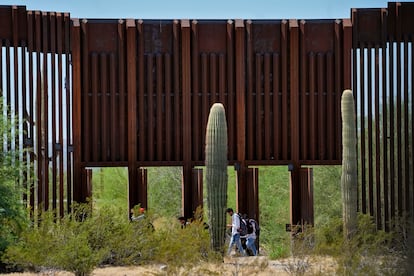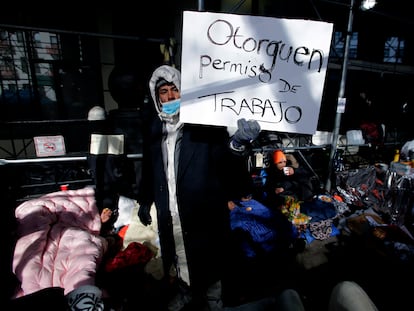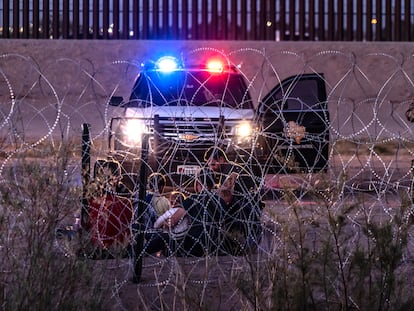Biden moves to allow more border wall construction in midst of immigration crisis
Democratic administration waives 26 federal laws that could result in up to 20 miles of barriers in South Texas in bid to contain surge in illegal arrivals from Mexico


The border wall with Mexico, one of former president Donald Trump’s most controversial works, has gained new life in the era of Joe Biden. The Department of Homeland Security (DHS) reported on Wednesday that the executive has waived 26 federal laws in South Texas. This allows Washington to build up to 20 miles (32 kilometers) of border barrier in the region, which has been overwhelmed in recent weeks due to the increase in the migratory flow from South America. It is the first time that the Democratic administration has used this executive power, which comes at a pressing moment for a president who is facing increasing criticism on more fronts for his management of the border.
The DHS announced the government’s decision in the U.S. Federal Registry. The notice acknowledged the tense moments experienced by several Texas border communities, which have seen the largest increase in illegal crossings in three years. “There is presently an acute and immediate need to construct physical barriers and roads in the vicinity of the border of the United States in order to prevent unlawful entries into the United States in the project areas,” said Alejandro Mayorkas, the DHS secretary, in the notice.
The executive order affects land located in Starr County, an area of 65,000 inhabitants where Texas converges with the Mexican state of Tamaulipas. Towns in that strip, such as Roma and Río Grande, witnessed an increase in illegal entries within a few months of Biden’s arrival at the White House. The pace of the crossings intensified, reaching 245,000 “encounters” (a euphemism that the government uses for arrests) during the fiscal year 2023, which covers October 2022 to September of this year.
The federal government is expected to release official figures for the last fiscal year in the coming days. Preliminary numbers in the hands of the DHS and the Border Patrol could break recent records. It is estimated that during the period, more than two million arrests were made along the more than 3,000 kilometers of the U.S.-Mexico border. The number of crossings increased sharply in August and September. It is estimated that last month alone some 50,000 Venezuelans entered the country illegally. The Biden administration has accelerated deportations and implemented agreements with other countries to stop the flow. It has also offered to expedite work permits for some migrants who are in U.S. territory. Meanwhile, the Republican governor of Texas, Greg Abbott, has ordered intensified checks at the border posts between Ciudad Juárez and El Paso, which has generated a monumental traffic jam of nearly 15,000 trucks.
The act of waiving federal laws on the border was common during the Trump administration. It was the former president’s preferred method to advance one of his most famous and controversial promises for immigration containment. By May 2020, the Republican administration had issued at least 30 orders to waive regulations in the region, according to a count by the Sierra Club, an environmental organization that argues that wall construction destroys the semi-desert ecosystem.

Environmentalists have criticized Biden’s decision under that same premise. Among the laws that have been passed in the area are those on clean air, water for human consumption and some that aimed to protect threatened species. With this tool, the executive avoids reviews and bureaucratic obstacles that could hinder rapid construction of border barriers. The DHS will use resources that Congress designated for that purpose in 2019, during Trump’s presidency, to build the wall. The former president built 450 miles (724 kilometers) of barriers between 2017 and January 2021.
Pressured by the surge in illegal arrivals, Biden has been forced to make a sharp U-turn in his immigration policy. On the first day of his presidency, on January 20, 2021, the Democratic president issued an order that ended the emergency on the border and redirected the money used for the construction of the wall to other causes. “Building a gigantic wall that covers the entire southern border is not a serious political solution,” Biden said. “It will be the policy of my administration that no more American taxes will be allocated to building a wall,” he added.
News of the reactivation of the border wall coincides with a visit by Antony Blinken, Biden’s Secretary of State, to Mexico, where he will meet with the Mexican president, Andrés Manuel López Obrador. On Thursday morning he will participate, along with his Mexican counterpart, Alicia Bárcena, in the High Level Dialogue on Security. On behalf of the American delegation, Mayorkas, Attorney General Merrick Garland, and Liz Sherwood, the White House Homeland Security Advisor, will also be at the meeting. The U.S. administration has on its agenda issues such as the proliferation of fentanyl trafficking, a drug that has become an epidemic, and immigration control along the complex common border.
Sign up for our weekly newsletter to get more English-language news coverage from EL PAÍS USA Edition
Tu suscripción se está usando en otro dispositivo
¿Quieres añadir otro usuario a tu suscripción?
Si continúas leyendo en este dispositivo, no se podrá leer en el otro.
FlechaTu suscripción se está usando en otro dispositivo y solo puedes acceder a EL PAÍS desde un dispositivo a la vez.
Si quieres compartir tu cuenta, cambia tu suscripción a la modalidad Premium, así podrás añadir otro usuario. Cada uno accederá con su propia cuenta de email, lo que os permitirá personalizar vuestra experiencia en EL PAÍS.
¿Tienes una suscripción de empresa? Accede aquí para contratar más cuentas.
En el caso de no saber quién está usando tu cuenta, te recomendamos cambiar tu contraseña aquí.
Si decides continuar compartiendo tu cuenta, este mensaje se mostrará en tu dispositivo y en el de la otra persona que está usando tu cuenta de forma indefinida, afectando a tu experiencia de lectura. Puedes consultar aquí los términos y condiciones de la suscripción digital.
More information
Archived In
Últimas noticias
Most viewed
- Reinhard Genzel, Nobel laureate in physics: ‘One-minute videos will never give you the truth’
- Oona Chaplin: ‘I told James Cameron that I was living in a treehouse and starting a permaculture project with a friend’
- Pablo Escobar’s hippos: A serious environmental problem, 40 years on
- Chevy Chase, the beloved comedian who was a monster off camera: ‘Not everyone hated him, just the people who’ve worked with him’
- Why we lost the habit of sleeping in two segments and how that changed our sense of time










































